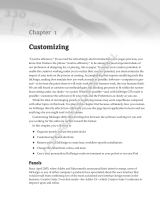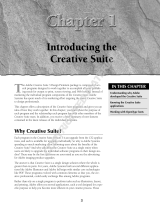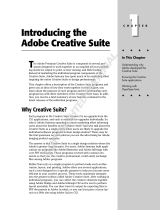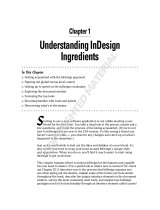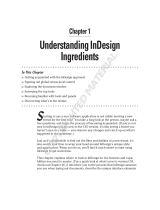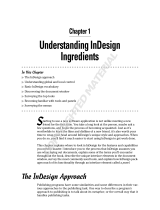Page is loading ...

I
nDesign CS3 is the fifth version of Adobe’s flagship publishing tool, a
product that came into its own with the third version (CS, which stands
for Creative Suite). Widely regarded as the best layout tool today,
InDesign CS3 continues to benefit from ongoing improvement from its
makers at Adobe Systems.
Every new version of InDesign has brought significant new capabilities to
your fingertips, and CS3 is no different. This new version introduces several
key additions that make it easier to produce flexible documents, such as
the ability to create text variables so the same document can have different
versions of, say, a chapter heading or copyright line. Catalog publishers,
for example, will love these additions. Adobe has also improved lots of
features — some big, some small — to both simplify the product’s use and
to enhance its capabilities. For example, a retooling of the feature palettes
helps reduce interface clutter, while the introduction of new lighting effects
extends design options.
For a quick overview of what’s new in InDesign CS3, Appendix B
puts it all in one place.
InDesign users fall into two camps: recent converts from QuarkXPress or
even the long-defunct PageMaker, and people who’ve used at least one previ-
ous version of InDesign. If you’re an experienced user of previous InDesign
versions, you already know the InDesign approach. That’s great — you’re a
step ahead! Feel free to skip this chapter or just skim it for a refresher. But if
you’re new to InDesign, please read on.
CROSS-REF
CROSS-REF
23
IN THIS CHAPTER
Learning what InDesign can do
Understanding global and local
control
Identifying InDesign terminology
What InDesign Can
Do for You
08_119389 ch01.qxp 5/23/07 12:32 AM Page 23
COPYRIGHTED MATERIAL

If you’re switching to InDesign from QuarkXPress or PageMaker, be sure to check out
Appendix C or Appendix D, respectively.
My book
QuarkXPress to InDesign: Face to Face
, also published by Wiley, provides a
detailed step-by-step transition guide for QuarkXPress users.
So what can InDesign do for you? A lot. For years, layout designers had to choose between a free-
form but manual approach to layout (PageMaker) and a structured but easily revised approach
(QuarkXPress). For years, most chose the latter. But with InDesign, you can choose both, which is
a key reason why it is now so widely acknowledged as the best publishing tool. InDesign’s flexible
approach is important for both novice and experienced users because there is rarely a one-size-fits-
all answer for all your design challenges. Sometimes (for example, if your project is a onetime pub-
lication or an experimental effort), creating a layout from scratch — almost as if you were doing it
by hand on paper — is the best approach. And sometimes using a highly formatted template that
you can modify as needed is the best approach because there’s no need to reinvent the wheel for
common documents.
InDesign can handle sophisticated tasks such as magazine and newspaper page layout, but its sim-
ple approach to publishing also makes it a good choice for smaller projects such as flyers and
newsletters. InDesign is also a good choice for corporate publishing tasks such as proposals and
annual reports. Plug-in software from other vendors add extra capabilities; for example, Virginia
Systems offers several plug-ins that make InDesign a good tool for books and academic papers.
For more on plug-in software, see Chapter 37.
But InDesign is not merely a merger of QuarkXPress and PageMaker — though it may seem that
way to experienced users. It is designed from the ground up as an electronic publishing tool. That
means you can easily send documents to service bureaus and printing presses for direct output,
saving you lots of time and money. It also means you can create documents for electronic distribu-
tion, particularly using the Adobe Portable Document Format (PDF) or the Web’s XHTML format,
though the latter capability assumes you’ll redesign the content’s appearance in a Web editing pro-
gram like Adobe Dreamweaver. These electronic files can include interactive features such as forms
and sounds. And InDesign uses a whole bunch of automation techniques — from text variables
through sharable styles and swatches — to ease the effort required to produce and maintain your
documents.
For more in-depth coverage of output and electronic-document fundamentals, see Parts
VII and VIII, respectively.
In this chapter, I detail the wide range of uses and features of InDesign, point out the ways in
which InDesign can be useful to you, and describe the basic metaphor on which the program is
based. I also provide a comprehensive list of the terms, clearly and concisely defined, that I use
throughout the book. So whether you’re an expert or novice, read on and prepare yourself for a
great InDesign adventure.
CROSS-REF
CROSS-REF
CROSS-REF
CROSS-REF
NOTE
NOTE
CROSS-REF
CROSS-REF
24
Welcome to InDesign
Part I
08_119389 ch01.qxp 5/23/07 12:32 AM Page 24

25
What InDesign Can Do for You
1
What Makes InDesign Special
T
he release of PageMaker in 1986 launched the desktop-publishing revolution, and in the follow-
ing years, PageMaker and its competitors added tons of cool features. It may be hard to imagine
that there’s anything new to add to this publishing toolkit.
Well, InDesign’s creators have managed to add a few new features. Following are the significant
additions to the desktop-publishing toolkit, courtesy of InDesign (note that this list doesn’t include
enhanced versions of features found in competitors such as QuarkXPress or in PageMaker):
n
Paragraph composer: This lets InDesign adjust the spacing and hyphenation over an
entire paragraph at once — rather than, as typical of other programs, one line at a time —
to achieve the best possible spacing and hyphenation. (See Chapter 18.)
n
Optical margin alignment: This actually moves some characters past the margin of your
columns to create the optical illusion that all the characters line up. It works because
some characters’ shapes fool the eye into thinking they begin before or after where they
really do, so although they’re technically aligned, they appear not to be. Optical margin
alignment fixes that. (See Chapter 19.)
n
Optical kerning: This adjusts the spacing between characters based on their shapes,
which provides for the most natural look possible without resorting to hand-tuning their
spacing. (See Chapter 17.)
n
A menu for inserting special characters: This makes it so you no longer have to remember
codes or use separate programs like the Mac’s Character Palette or the Windows
Character Map to add special symbols like bullets (•) and section indicators (§). Your
word processor has likely had this feature for a few years, but this is a first in desktop pub-
lishing. (See Chapter 21.)
n
Glyph scaling: This lets InDesign stretch or compress characters to make them fit better on
a line. (A
glyph
is a character.) This works in addition to tracking and kerning, which
adjust the spacing between characters to make them fit better on a line. (See Chapter 17.)
n
Custom strokes for characters: This lets you change the look of characters by making
their outlines thicker or thinner. You can also give the part of the characters inside the out-
lines a different color to create an outline effect. (Typically, the part inside the stroke is the
same color as the stroke, so the reader sees a normal, solid character.) (See Chapter 12.)
n
EPS display: This feature lets you see the detailed contents of an EPS file rather than rely
on a poor-quality preview image or, worse, see an X or gray box in place of the image.
(See Chapter 26.)
n
Illustrator and Photoshop file import: This lets you place these graphics files directly in
your layout. (See Chapter 26.)
n
Multiple views of the document: This lets you have several windows open for the same
document, enabling you to see different sections at the same time. (See Chapter 3.)
continued
08_119389 ch01.qxp 5/23/07 12:32 AM Page 25

Understanding Global and Local Control
The power of desktop publishing in general and InDesign in particular, is that it lets you automate
time-consuming layout and typesetting tasks while letting you customize each step of the process
according to your needs. This duality of structure and flexibility — implemented via the dual use
of the frame-based and free-form layout metaphors — carries over to all operations, from typogra-
phy to color. You can use global controls to establish general settings for layout elements and then
use local controls to modify those elements to meet specific publishing requirements. The key to
using global and local tools effectively is to know when each is appropriate.
Global tools include:
n
General preferences and application preferences (see Chapter 3)
n
Master pages (see Chapter 7)
n
Text styles (see Chapter 20)
n
Table and cell styles (see Chapter 22)
n
Object styles (see Chapter 13)
n
Stroke styles (see Chapter 12)
26
Welcome to InDesign
Part I
continued
n
Lighting effects: This set of features lets you give dimensional effects to text through the
use of custom drop shadows and other effects. (See Chapter 12.)
n
Transparency: This lets you make objects fade to create special effects as they overlap or
for ghost-like visuals. (See Chapter 12.)
n
Automated spell-checking and text correction: This is similar to Microsoft Word’s nonin-
vasive correction tools. (See Chapter 16.)
InDesign also includes a few features that aren’t new in desktop publishing history but have not been
available to mainstream programs for many years:
n
Object styles: This lets you apply a range of attributes, such as fill and stroke, to an object
and reuse those same settings on other objects. (See Chapter 13.)
n
Table and cell styles: These let you apply consistent formatting to entire tables or to indi-
vidual cells, as well as reuse those settings in other tables and cells. (See Chapter 22.)
n
Text variables: This feature lets you have InDesign automatically insert and keep updated
information such as chapter numbers, filenames, creation dates, and anything you choose
to define as a variable. (See Chapter 23.)
n
Footnotes: This is similar to how word processors handle this annotation method. (See
Chapter 24.)
n
Follow-me anchored objects: This lets you keep items such as figures and sidebars with
text as it flows throughout a document. (See Chapter 12.)
08_119389 ch01.qxp 5/23/07 12:32 AM Page 26

n
Text variables (see Chapter 23)
n
Sections of page numbers (see Chapter 5)
n
Color definitions (see Chapter 8)
n
Hyphenation and justification (see Chapter 18)
n
Libraries (see Chapter 7)
Styles and master pages are the two main global settings that you can expect to
override locally throughout a document because — although the layout and typographic
functions that styles and master pages automate are the fundamental components of any document’s
look — they don’t always work for all of a publication’s specific content.
Local tools include:
n
Frame and shape tools (see Part III and Chapters 27 and 28)
n
Character and paragraph tools (see Chapters 17, 18, 19, and 20)
n
Graphics tools (see Part VI)
In many cases, it’s obvious which tool to use. If, for example, you maintain certain layout standards
throughout a document, then using master pages is the obvious way to keep your work in order.
Using styles is the best solution if you want to apply standard character and paragraph formatting
throughout a document. When you work with special-case documents, such as single-page display
ads, it doesn’t make much sense to spend time designing master pages and styles — it’s easier just
to format one-of-a-kind elements on the fly.
In other cases, deciding which tool is appropriate is more difficult. For example, you can create a
drop cap (a large initial letter set into a paragraph of type, like the one that starts each chapter in
this book) as a character option in the Character panel, or you can create a character style (format-
ting that you can apply to any selected text, ensuring the same formatting is applied each time)
that contains the drop-cap settings and apply that style to the drop cap. The method you choose
depends on the complexity of your document and how often you need to perform the action. The
more often you find yourself doing something, the more often you should use a global tool (such
as character styles).
Fortunately, you don’t have to decide between global and local tools right away while designing a
document. You can always create styles from existing formatting later or add elements to a master
page if you find you need them to appear on every page.
Another situation in which you can choose between local or global controls is specifying measure-
ment values. Regardless of the default measurement unit you set (and that appears in all dialog
boxes and panels), you can use any unit when entering measurements in an InDesign dialog box.
If, for example, the default measurement is picas, but you’re accustomed to working with inches,
go ahead and enter measurements in inches.
Chapter 3 covers how to apply measurement values and how to set your preferred
defaults.
CROSS-REF
CROSS-REF
NOTE
NOTE
27
What InDesign Can Do for You
1
08_119389 ch01.qxp 5/23/07 12:32 AM Page 27

InDesign Vocabulary 101
I
nDesign comes with its own terminology, much of it adopted from other Adobe products. The gen-
eral terms include the following:
n
Frame: The container for an object, whether text, graphic, or color fill.
n
Link: The connection that InDesign makes to an imported file; the link contains the file’s
location, last modification date, and last modification time. A link can reference any
image or text file that you have imported into a layout. InDesign can notify you when a
source text or graphics file has changed, so you can choose whether to update the version
in your layout. (A
hyperlink,
often also abbreviated to
link
in casual conversation, con-
nects elements in a Web page to other Web pages or other resources such as PDF files.)
n
Package: The collecting of all files needed to deliver a layout for commercial printing.
n
Pane: A section of a dialog box or panel whose options change based on what set of con-
trols you’ve selected in the dialog box or panel.
n
Panel: A container for controls that stays on-screen even when you aren’t using it (unlike a
dialog box, which appears only while you are using it). Panels, which used to be called
palettes
, can be docked to the right edge of the screen or free-floating. Panels can be
combined into a single container called a
panel group
.
n
Path: A shape in which the endpoint and start point are separate, keeping the shape
“open.” Lines are a straight type of path.
n
PDF: The Adobe Portable Document Format is the standard for electronic documents. No
matter what kind of computer it is viewed on (Windows, Macintosh, Palm, or Unix), a
PDF document retains high fidelity to the original in typography, graphics representation,
and layout. InDesign can both place PDF files as if they were graphics and export its own
pages as PDF files.
n
Place: To import a graphics file or text file.
n
Plug-in: A piece of software that loads into InDesign and becomes part of it, adding more
capabilities.
n
Stroke: The outline of an object (whether a frame, a line, or an individual text character).
n
Thread: The links between text frames that route stories among them.
Summary
InDesign offers a strong set of features for professional publishers working on brochures, maga-
zines, advertisements, and similar publications. It offers many unique features such as a multiline
composer, glyph scaling, and customer character strokes.
28
Welcome to InDesign
Part I
08_119389 ch01.qxp 5/23/07 12:32 AM Page 28
/
